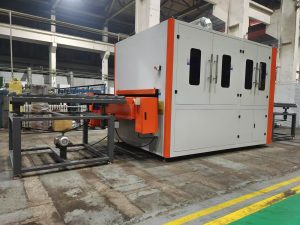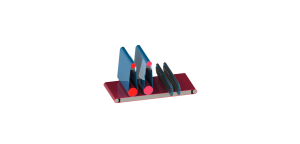In high-volume metal manufacturing, automated deburring machines are transforming how metal parts are processed. Burrs—sharp edges or metal fragments left on parts after machining—are a significant concern in industries such as automotive, aerospace, and electronics. Automated deburring systems provide a highly effective solution to remove burrs and ensure that components are safe, functional, and aesthetically flawless. This technological advancement enhances manufacturing efficiency, reduces labor costs, and increases production throughput.

The Importance of Metal Deburring in High-Volume Manufacturing
Deburring is an essential part of the post-processing stage in manufacturing, where precision is key. During operations like cutting, drilling, or grinding, burrs often form on metal parts, posing various issues. These include:
- Safety hazards for workers who handle the parts.
- Decreased functionality or improper fitting of parts during assembly.
- Aesthetic defects, compromise the visual appeal of the product.
- Additional costs for reworking, repairing, or scrapping defective parts.
To meet the demands of modern high-volume manufacturing, especially for critical applications in automotive or medical device production, automated deburring machinery offers a more efficient, accurate, and scalable solution to these challenges.
Key Benefits of Automated Metal Deburring Machines
-
Enhanced Manufacturing Productivity and Throughput
One of the most significant advantages of automated deburring systems is their ability to improve production efficiency. Traditional manual deburring is time-consuming and often inconsistent. With automated solutions, manufacturers can deburr metal parts faster, increasing throughput while maintaining precision. This means high-quality components can be produced in less time, which is critical in industries like aerospace and automotive manufacturing, where speed and quality go hand-in-hand.
-
Consistent Quality and Precision
Automated deburring machines eliminate the variability seen in manual deburring, providing uniform burr removal across thousands of parts. These machines use precision settings to ensure that each part is deburred to the same high standard, reducing the potential for defects and ensuring consistent part quality. Whether you’re deburring aluminum parts or stainless steel components, automation guarantees superior and repeatable results.
-
Cost Savings through Labor Reduction and Error Minimization
Automated deburring helps reduce labor costs by eliminating the need for manual intervention in the deburring process. As automation handles the repetitive task, the risk of human error is significantly reduced. Fewer defects mean fewer parts are scrapped or reworked, contributing to cost savings and better resource management. Moreover, automated systems operate 24/7, offering enhanced manufacturing flexibility.
-
Improved Workplace Safety
Manual deburring involves sharp metal parts and dangerous tools, putting operators at risk for injuries. Automated deburring machines reduce these hazards, improving the overall safety of the work environment. With the automation of the deburring process, manufacturers can ensure that employees focus on more skilled and less dangerous tasks, enhancing workplace safety and reducing potential liability.
-
Versatility for Different Materials and Part Sizes
One of the standout features of automated metal deburring is its versatility. Whether dealing with large or small parts, and materials ranging from steel to aluminum to titanium, automated systems can be adapted to handle various materials and part geometries. This makes automated deburring ideal for industries with diverse production lines that require quick changeovers without compromising part quality.
-
Minimized Material Waste and Improved Resource Utilization
Automated systems are more efficient at removing the exact amount of material required. Unlike manual processes, which often lead to over-deburring or unnecessary material removal, automated deburring machines optimize material usage, reducing both waste and costs. This eco-friendly benefit contributes to more sustainable manufacturing processes and reduced environmental impact.
-
Superior Surface Finish and Aesthetic Quality
In applications where visual appeal is essential, such as in the electronics or consumer goods industries, automated deburring machines provide a smooth, polished finish that manual methods may struggle to achieve consistently. The smooth surface finish enhances both the look and functionality of the end product, resulting in better consumer satisfaction.
Types of Automated Metal Deburring Machines
The deburring machine market offers several types of automated systems, each tailored for specific deburring needs:
-
Vibratory Deburring Machines: Using vibration and abrasive media, these systems are ideal for deburring small to medium-sized parts with complex shapes.
-
Rotary Deburring Machines: These machines employ rotating brushes, belts, or wheels to remove burrs from larger or heavier parts with high precision.
-
Centrifugal Deburring Machines: Ideal for bulk processing, centrifugal systems use high-speed rotation to deburr large volumes of parts in one cycle.
-
Laser Deburring Machines: Utilizing focused laser technology, these machines provide precise burr removal without physical contact, ideal for delicate or highly intricate components.

The Future of Automated Deburring in High-Volume Manufacturing
The growing adoption of automated metal deburring machines is a clear indication of the manufacturing sector’s shift towards smart manufacturing. These systems are not just a passing trend but a long-term solution for companies striving to meet increasing production demands while maintaining high quality. As technology evolves, newer systems will offer even greater automation integration, such as robotic deburring or AI-driven systems, further streamlining the manufacturing process.
Manufacturers who integrate automated deburring solutions into their operations are positioning themselves to thrive in a competitive market. The benefits of automation extend beyond faster production times—they contribute to higher-quality products, improved worker safety, and long-term cost efficiency.
Why Automated Deburring is Key for Future-Ready Manufacturing
Automated metal deburring machines are becoming a staple in modern manufacturing environments, providing a robust solution for burr removal and improving the overall production process. With advantages such as increased productivity, reduced labor costs, consistent quality, and enhanced safety, these systems are essential for industries that demand high performance, including automotive, electronics, and aerospace.
As the industry continues to evolve, automated deburring technology will remain crucial for manufacturers who seek to maintain a competitive edge and deliver products that meet the highest standards of quality and efficiency.
